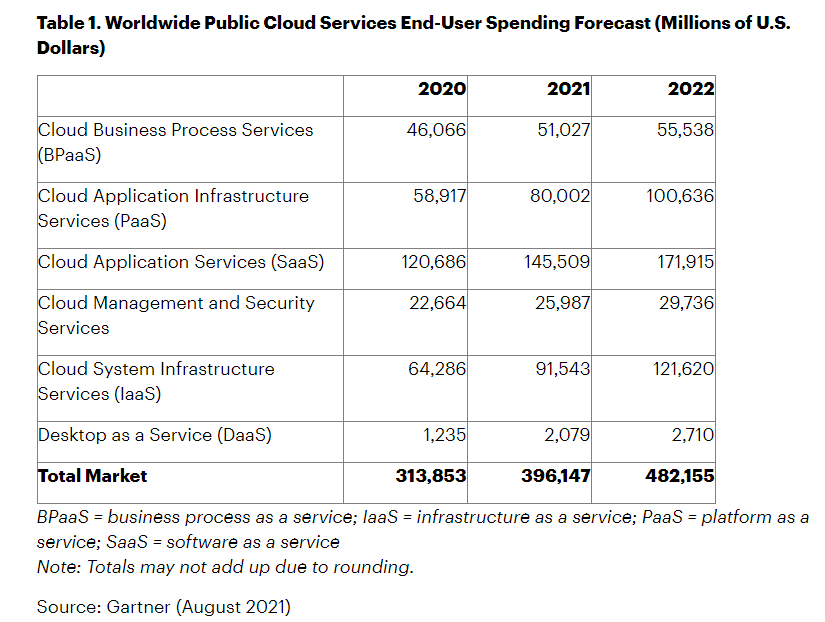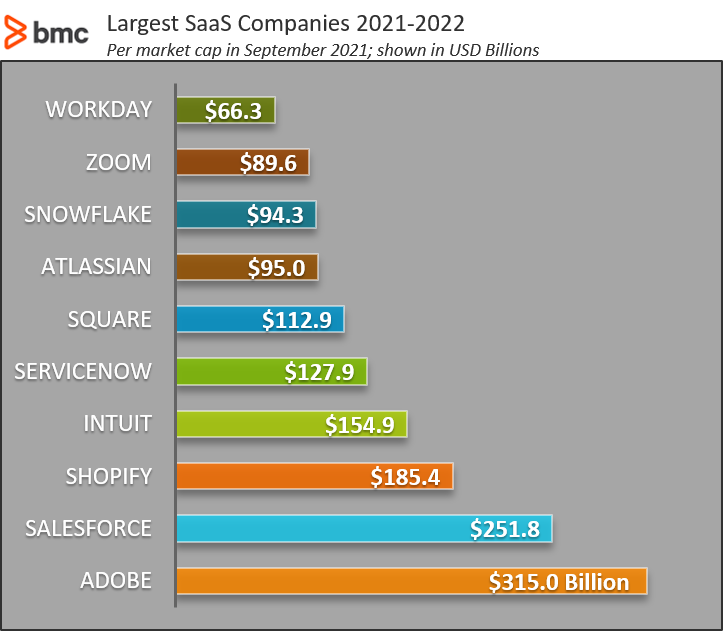SaaS solutions are among the fastest-growing segments in the IT industry. Working on a subscription basis and centrally located on a remote cloud network, software as a service (SaaS) models are becoming the go-to for many organizations for a variety of reasons, including flexibility and affordability.
Of course, with the pandemic necessitating more remote work than ever, the need for SaaS will only increase.
In this article, we’ve put together some of the top trends and growth statistics surrounding SaaS solutions for 2022. Let’s take a look.
SaaS spending vs overall IT spending
Although global businesses and economies suffered this past year due to the pandemic, cloud growth continued to boom.
“Organizations are advancing their timelines on digital business initiatives and moving rapidly to the cloud in an effort to modernize environments, improve system reliability, support hybrid work models and address other new realities compelled by the pandemic,” said Brandon Medford, senior principal analyst at Gartner
In fact, Gartner forecasts end-user spending on public cloud services to reach $396 billion in 2021—and grow 21.7% to reach $482 billion in 2022.
“The economic, organizational and societal impact of the pandemic will continue to serve as a catalyst for digital innovation and adoption of cloud services,” said Henrique Cecci, senior research director at Gartner. “This is especially true for use cases such as collaboration, remote work and new digital services to support a hybrid workforce.”
Cloud growth: SaaS vs other cloud services
Among cloud options, the outlook for SaaS is arguably the brightest. After all, the overall growth of the SaaS industry will remain consistent through these years as more companies adopt SaaS solutions for a variety of business functions, extending far beyond the initial SaaS territories of core engineering and sales applications.
As the first cloud service to truly take off, SaaS has a significant lead on other cloud services. Gartner estimates that SaaS will continue to maintain this dominance well into 2022:

The SaaS growth rate, however, is beginning to slow, especially compared to other cloud services like platform as a service (PaaS) and infrastructure as a service (IaaS), both of which are projected to double from just 2020.
(Understand SaaS fully in our SaaS vs PaaS vs IaaS explainer.)
Largest SaaS companies
We can also look at SaaS success in terms of the companies that make those products. In the first part of 2021, the 10 largest publicly owned SaaS companies per market cap were:

(Source)
Compared to similar numbers from 2020, the growth these companies have experienced is astronomical. For example:
- Salesforce alone grew from $161 billion in January 2020 to $251 billion in September 2021.
- Similarly, Shopify evaluation in early 2020 was $52.1 billion compared to more than $185 billion today—that’s 225% growth in 20 months!
Notable industry giants that are missing from this list include Microsoft and Oracle. It’s important to realize, however, that a significant portion of their revenue comes from selling on-premises software—so while they are huge tech companies, calling them SaaS providers is a misnomer.
This demand for subscription-based pricing models, however, is spurring legacy companies to rapidly migrate their software solutions to a SaaS consumption model.
This means strong potential for growth of SaaS products in the coming years as their Total Cost of Ownership (TCO) matches that of the on-premise software deployment models. Organizations dominating the enterprise software space—IBM, Oracle, Microsoft, and SAP—will likely maintain their market share for enterprise software products, as a growing number of customers can take advantage of the same product capabilities with the feasible subscription-based pricing model.
SaaS acquisitions & IPOs
Of course, SaaS growth doesn’t stop with revenue projections. SaaS acquisitions feel as if they’re happening daily, as bigger companies look for the next big SaaS thing. Stability of the economy and investor interest in scalable cloud solutions have encouraged entrepreneurs, innovators, and enterprises to develop new SaaS solutions.
SaaS acquisitions in 2021
Notable SaaS acquisitions from the first half of 2021 include:
- Docsend, which allows customers to share and track documents using a secure link, was acquired by Dropbox for $165 million.
- Networking hardware titan Cisco bought up Kenna Security, a market leader in risk-based vulnerability management.
- Chorus.ai, a conversation intelligence leader, was acquired by ZoomInfo in July for $575 million.
- Panasonic Corporation completed the acquisition of the leading end-to-end, digital fulfillment platform provider Blue Yonder.
Recent SaaS IPOs
With the recent shifts in the workplace landscape, industry leaders have continued to lean on SaaS solutions. This increase in business created a clear path for multiple SaaS companies to IPO in 2021. In fact, the number of businesses specializing in SaaS that have IPOed in 2021 has increased 125% compared to the same period in 2020.
Significant SaaS IPO news of the last year:
Couchbase
NoSQL database specialist Couchbase debuted on the market on July 22, with a price jump of 39% to $33.25 a share on its first day, valuing the company at more than $1 billion.
SentinelOne
Cybersecurity firm SentinelOne closed markets at $42.50 per share on its June 30 debut, valuing the company at $10 billion. The company specializes in endpoint security, using machine learning (ML) to combat cyber-attacks.
(See more ML use cases in the business.)
Confluent
Debuting on June 23, Confluent ended the day at $36 per share, putting its value at $9 billion. The company provides an enterprise version of the popular open-source Kafka streaming data platform.
Sprinklr
Software maker Sprinklr is best known for its media management, advertising, and content marketing tools, used by some of the biggest brands in the world. The company sat at $16 per share at its IPO in June, valuing it at $4 billion.
SaaS adoption & workforce size
We can also measure SaaS growth in terms of adoption: are customers using more, less, or the same number of SaaS products?
The number and type of users of SaaS products has increased rapidly in recent years. Though initially positioned as ideal for SMBs and startups, companies of all shapes and sizes are finding SaaS a palatable, affordable solution that empowers agility and digital transformation.
Recent research finds that:
- The SaaS market is currently growing by 18% each year
- By the end of 2021, 99% of organizations will be using one or more SaaS solutions
- Nearly 78% of small businesses have already invested in SaaS options
- SaaS adoption in the healthcare industry grows at a rate of 20% per year
- 70% of CIOs claim that agility and scalability are two of the top motivators for using SaaS applications
The proportionality of SaaS adoption to workforce size is attributed to several factors:
- Small organizations tend to work on a limited set of projects that naturally require a limited set of products. As the organization grows and the number of teams increase, users working on different projects may have their own requirement for the SaaS tools.
- To avoid the issues resulting from shadow IT—the adoption of unapproved software at the workplace—including cost and security, large organizations make it easier to provision many SaaS resources as necessary.
- The complexity of large-scale projects at the enterprise level means that no single SaaS solution delivers all necessary functionality. Users who rely on multiple SaaS solutions to address their technology requirements may adopt several products designed for the same target audience and application use cases.
Why is SaaS so popular?
Customers are increasingly adopting the subscription-based pricing model to satisfy growing IT needs—despite limited IT budgets particularly for SMBs and startups. Established enterprises aren’t looking down at SaaS either, despite their size. Instead, they’re wholeheartedly embracing the as-a-service business model to satisfy diverse needs with agile, modern solutions.
The result is a suitable business environment that facilitates healthy competition among SaaS vendors while the market demand continues to increase exponentially.
Research suggests that the number of competitors for SaaS firms starting around 2012 were less than three on average. By the end of 2017, every SaaS startup faced competition from nine other firms competing in the same SaaS market segment. Considering the example of SaaS marketing solutions, the number of products increased from 500 to 8,500 between 2007 and 2017.
SaaS growth rates, IPOs, and acquisitions all indicate this trend is not ending anytime soon.
SaaS benefits for the customer
From a customer perspective, SaaS products offer a variety of benefits:
- SaaS delivers higher strategic value versus on-premise software deployments. With a SaaS model, software deployment time has reduced from several weeks and days to a few minutes.
- The wealth of enterprise SaaS solutions available gives users a diverse set of resources to address varied demands. As a result, organizations are experiencing higher levels of employee engagement with feature-rich SaaS solutions designed for improved customer experience.
- SaaS vendors are also able to push feature improvements, bug fixes, and security updates on the fly. These capabilities with on-premise deployments were previously required to pass through several layers of organizational protocols and governance before eventually reaching end-users.
SaaS technologies have made it easier for enterprises and software vendors to effectively deliver the necessary features and functionality to end-users, ultimately contributing to the popularity of SaaS solutions over on-premise software products.
SaaS Trends in 2022
Overall, the rise of software as a service solutions isn’t going anywhere. Both small and large businesses are utilizing SaaS in some form, and as these options continue to expand, this percentage will only increase.
Related reading
- BMC Multi-Cloud Blog
- 5 Practices for Controlling Costs as You Move to SaaS
- Cloud Revenue & Market Share Trends Today
- The Multi-Cloud & How To Create A Multi-Cloud Strategy
- Cloud Service Providers (CSPs) Explained
These postings are my own and do not necessarily represent BMC's position, strategies, or opinion.
See an error or have a suggestion? Please let us know by emailing blogs@bmc.com.






